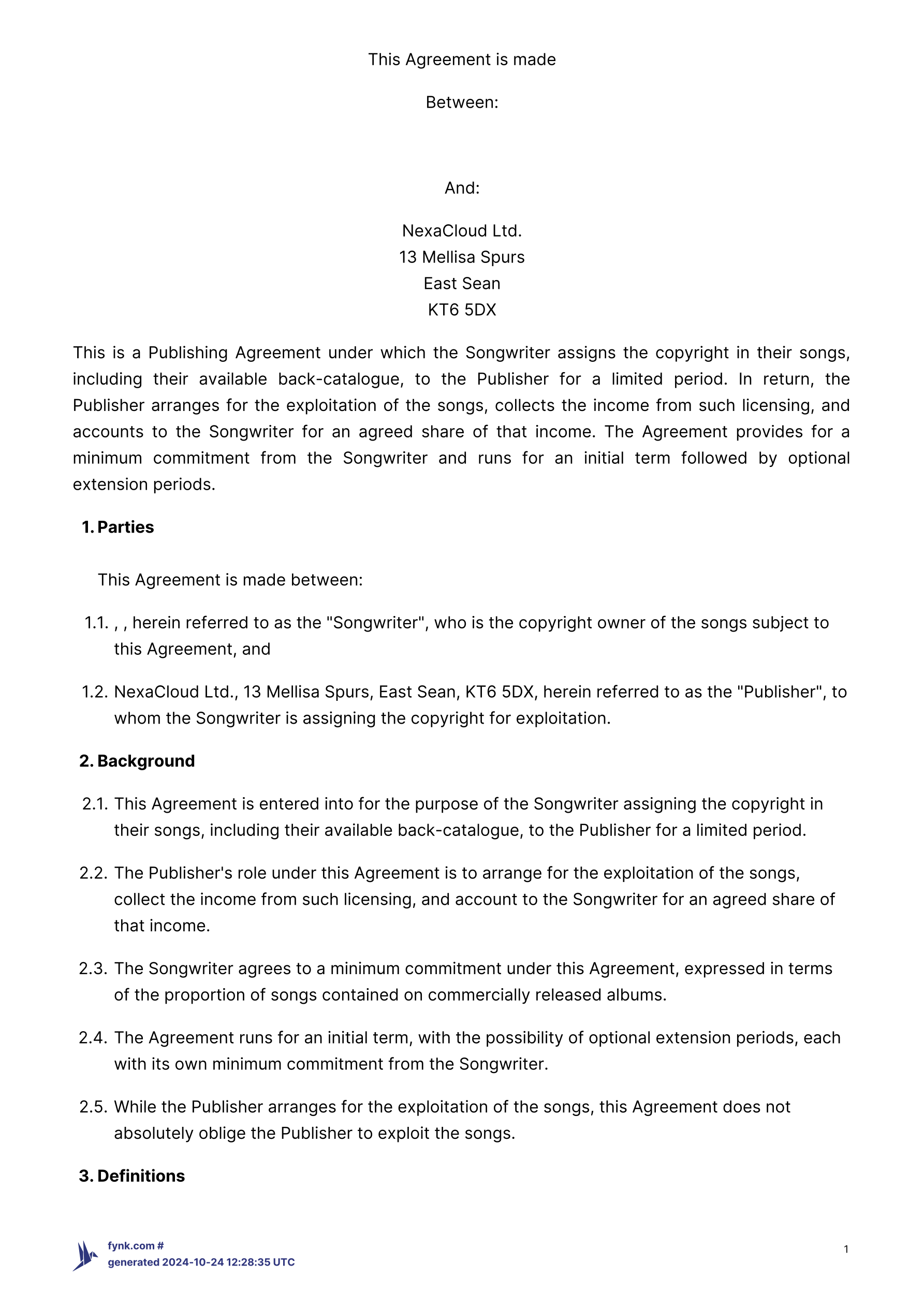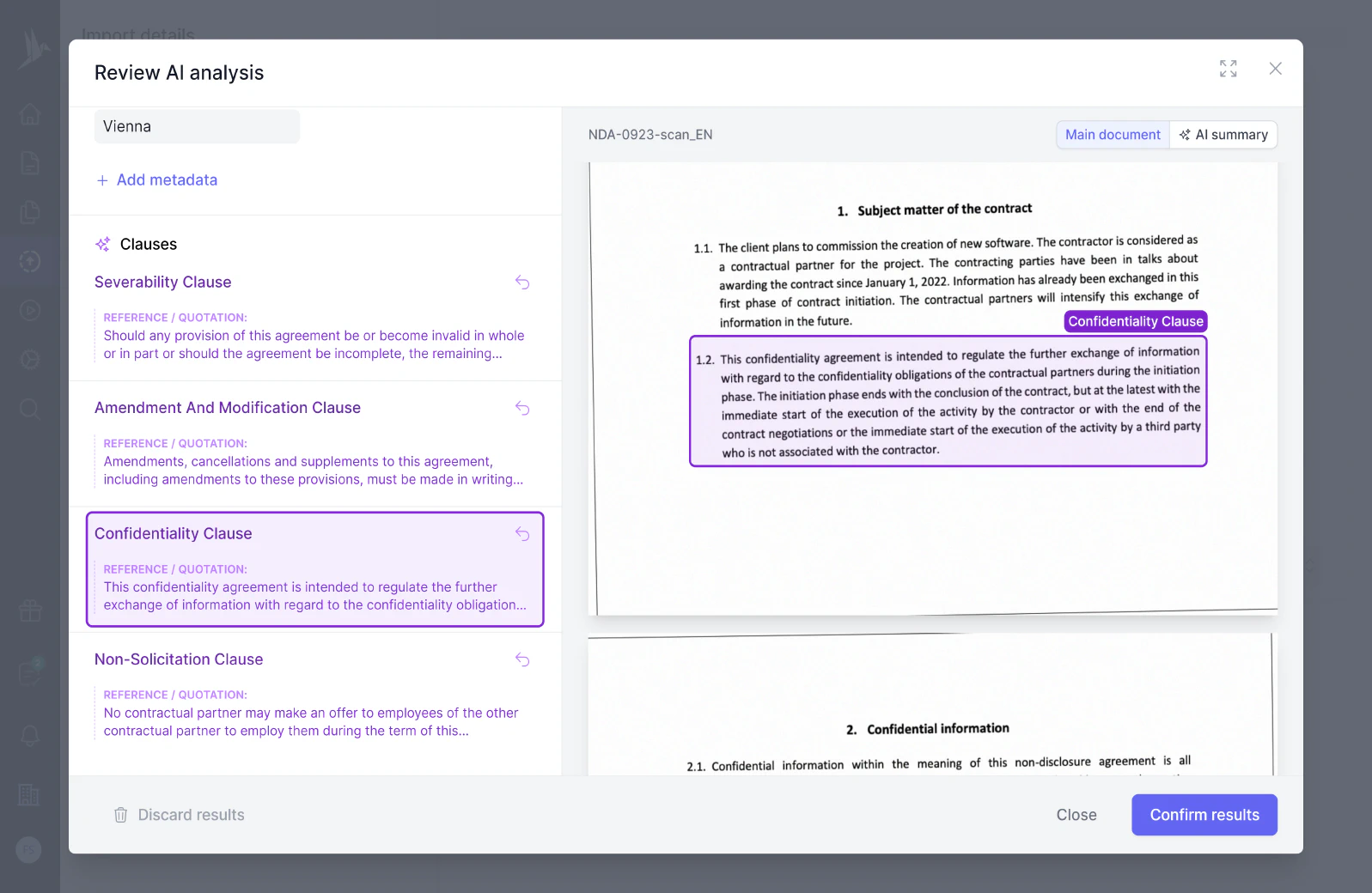
Publishing Agreement Template - Songwriter
A publishing agreement is a legal contract that defines the terms and rights a creator grants to a publisher for managing and exploiting their creative works.
The "Right to Indemnification" clause in a contract ensures that one party (typically the indemnitee) is protected from any losses, damages, or liabilities incurred as a result of the actions or omissions of another party (the indemnitor). This clause obligates the indemnitor to compensate the indemnitee for any costs or legal fees arising from claims, effectively shifting the risk from one party to the other.
Right to Indemnification. In the event that Section 5(a) is inapplicable, the Company shall indemnify Indemnitee pursuant to this Agreement unless, and except to the extent that, it shall have been determined by one of the methods listed in Section 8(b) that Indemnitee has not met the applicable standard of conduct required to entitle Indemnitee to such indemnification.
Determination of Right to Indemnification. A determination of Indemnitee’s right to indemnification under this Section 8 shall be made at the election: (i) by a majority vote of directors who are not parties to the Proceeding for which indemnification is being sought, even though less than a quorum; (ii) by a committee of the Board consisting of directors who are not parties to the Proceeding for which indemnification is being sought, who, even though less than a quorum, have been designated by a majority vote of the disinterested directors; (iii) if there are no such disinterested directors or if the disinterested directors so direct, by Independent Counsel chosen by the Company in a written opinion to the Board, a copy of which shall be delivered to Indemnitee; or (iv) by the Company’s stockholders. However, in the event there has been a Change in Control, then the determination shall, at Indemnitee’s sole option, be made by Independent Counsel as in (b)(iii) above, with Company choosing the Independent Counsel subject to Indemnitee’s consent, such consent not to be unreasonably withheld.
If successful in whole or in part in any suit brought pursuant to Section 5.5(a) of this Article V, or in a suit brought by the Corporation to recover an advancement of expenses (whether pursuant to the terms of an undertaking or otherwise), the person seeking to enforce a right to indemnification or an advancement of expenses hereunder or the person from whom the Corporation sought to recover an advancement of expenses, as the case may be, shall be entitled to be paid by the Corporation the reasonable expenses (including attorneys’ fees) of prosecuting or defending such suit.
In any suit brought by a person seeking to enforce a right to indemnification hereunder (but not a suit brought by a person seeking to enforce a right to an advancement of expenses hereunder), it shall be a defense that the person seeking to enforce a right to indemnification has not met any applicable standard for indemnification under applicable law. With respect to any suit brought by a person seeking to enforce a right to indemnification or right to advancement of expenses hereunder or any suit brought by the Corporation to recover an advancement of expenses (whether pursuant to the terms of an undertaking or otherwise), neither (i) the failure of the Corporation to have made a determination prior to commencement of such suit that indemnification of such person is proper in the circumstances because such person has met the applicable standards of conduct under applicable law, nor (ii) an actual determination by the Corporation that such person has not met such applicable standards of conduct, shall create a presumption that such person has not met the applicable standards of conduct or, in a case brought by such person seeking to enforce a right to indemnification, be a defense to such suit.
Right to Indemnification. 1. Each person (and the heirs, executors or administrators of such person) who was or is a party or is threatened to be made a party to, or is involved in any threatened, pending or completed action, suit or proceeding, whether civil, criminal, administrative or investigative (including without limitation, an action by or in the right of the Corporation), by reason of the fact that such person is or was a director or officer of the Corporation or while serving as a director or officer of the Corporation is or was serving at the request of the Corporation as a director or officer of another corporation, partnership, joint venture, trust or other enterprise, shall be indemnified and held harmless by the Corporation to the fullest extent now or hereafter permitted by the DGCL. The right to indemnification conferred in this Article V shall also include the right to be paid by the Corporation all of the costs, fees and the expenses (including attorney’s fees and costs, judgments, fines, ERISA or other excise taxes, penalties, interest, and amounts paid in settlement) incurred in connection with any such action, suit, or proceeding in advance of its final disposition to the fullest extent permitted by the DGCL. The termination of any such action, suit or proceeding by judgment, order, settlement, conviction or upon a plea of nolo contendere or its equivalent, shall not, of itself, create a presumption that such person is not entitled to indemnification hereunder. To the fullest extent permitted by the DGCL, any present or former director or officer of the Corporation who brings a claim against the Corporation to enforce such person’s rights under this Article V shall be entitled to the advancement of expenses and, to the extent successful, indemnification by the Corporation in connection with the prosecution of such claim. The right to indemnification and advancement conferred in this Article V shall be a contract right.
The right to indemnification conferred in this Article IV shall include the right to receive payment of any expenses incurred by the indemnitee in connection with such Proceeding in advance of the final disposition of the Proceeding, consistent with applicable law as then in effect. All rights to indemnification conferred in this Article IV, including rights to the advancement of expenses and the evidentiary, procedural and other provisions of this Article IV, shall be contract rights.
Indemnitee shall have the right to employ Indemnitee’s own counsel in connection with establishing Indemnitee’s right to indemnification. In all events, the Corporation shall pay (i) all of the Expenses of the Independent Legal Counsel incurred in connection with successfully establishing Indemnitee’s right to indemnification and (ii) if applicable, all Expenses of Indemnitee’s own counsel incurred in connection with successfully establishing Indemnitee’s right to indemnification. The Indemnitee’s other Expenses incurred in connection with successfully establishing Indemnitee’s right to indemnification, in whole or in part, in any such proceeding or otherwise shall also be indemnified by the Corporation.
The “Right to Indemnification” refers to a legal provision often found in contracts, allowing one party to be compensated for losses incurred due to actions or inactions of another party. This right serves as a financial guarantee that aims to protect parties from potential risks associated with a contract. Indemnification ensures that a party is not financially burdened due to liabilities, damages, or losses arising during the performance of a contractual duty.
You should consider incorporating the right to indemnification when you want to protect yourself or your business from potential risks and liabilities associated with a contractual relationship. It is particularly useful in situations where there is potential for significant financial loss, such as:
When drafting the right to indemnification in a contract, it is crucial to be precise and clear about the terms and conditions. Here is a basic structure you might follow:
Identify the parties involved: Clearly state which party is indemnifying and which party is being indemnified.
Define the scope: Specify what types of actions, losses, or damages the indemnification covers.
Include limitations or exclusions: State any circumstances under which indemnification would not apply.
Procedure for claims: Outline the process to be followed when an indemnification claim is made, including notice requirements and dispute resolution methods.
Example clause:
“Party A agrees to indemnify, defend, and hold harmless Party B against any and all claims, damages, losses, and expenses (including reasonable attorney’s fees) arising out of or resulting from negligence, breach of contract, or willful misconduct by Party A, except as such loss results from the gross negligence or willful misconduct of Party B.”
The right to indemnification is a common feature in various types of contracts, particularly where risk transfer is a significant concern. Typical contracts that contain indemnification clauses include:
Each contract may have specific needs and thus, the indemnification clause should be tailored to address those particular risks appropriately.
These templates contain the clause you just read about.

A publishing agreement is a legal contract that defines the terms and rights a creator grants to a publisher for managing and exploiting their creative works.
Dive deeper into the world of clauses and learn more about these other clauses that are used in real contracts.
The "Right to Subcontract" clause allows a party in a contract to delegate their obligations or tasks to a third-party subcontractor, subject to any limitations or conditions outlined in the agreement. This clause typically ensures that the original party remains responsible for the performance of their contractual duties, even if those duties are executed by the subcontractor.
A "Right to Sublet" clause allows a tenant to lease their rented property to a third party, either entirely or partially, with certain conditions or restrictions set by the landlord. This clause typically requires the tenant to obtain the landlord's consent before subletting, ensuring the subtenant meets specific criteria.
The royalties clause in a contract outlines the percentage or fixed amount paid to a party, usually the creator or owner, for the use or sale of their intellectual property or product. It specifies the payment terms, frequency, and conditions under which royalties are calculated and distributed.
Try our AI contract analysis and extract important clauses and information from existing contracts.
< <
Fill out the form and we will get in touch with you to give you a personal, customized demo of fynk.
Greetings!
I'm Markus, co-founder of fynk. After you've submitted the form, I'll swiftly get in touch with you.
Also, right after you submit your details, you can pick a time that works best for you for our meeting.

